Play
Part 1 - Step by Step
- InstructInstruct students that they will be preparing to compete in the Village Engineering Construction Competition! In their teams, they will need to choose which tasks on the Field they want to try to complete in order to score the most points in their match. They will need to listen to one another, communicate clearly, and compromise in order to develop and practice their strategy. View the video below to learn more about preparing for the Village Engineering Construction Competition.
Note: You can choose how students interact with the video content. The video is embedded within the Lab 5 Image Slideshow to share easily with students. Or, you may choose to watch the video yourself and present the information to your students in class.
- ModelModel for students how to collaborate and use teamwork to develop a strategy for the competition. The goal of this practice is to come up with a strategy idea, test it with the Hero Robot, figure out how well it worked, and what to add or change to make your strategy better for the competition.
- Model how to use the engineering design process to develop a strategy:
- First, ask students how many tasks they think they can accomplish in a two minute match, based on their experiences in previous Labs. Start simply with 3 or 4 tasks for your initial strategy. For a list of tasks, see the Village Engineering Construction Competition Activity (Google Doc/.docx/.pdf).
-
Next, ask students which tasks they think they should try to complete in their strategy, and add them to the Data Collection Sheet. Use the example image below for reference on how to use the Data Collection Sheet for strategy development.
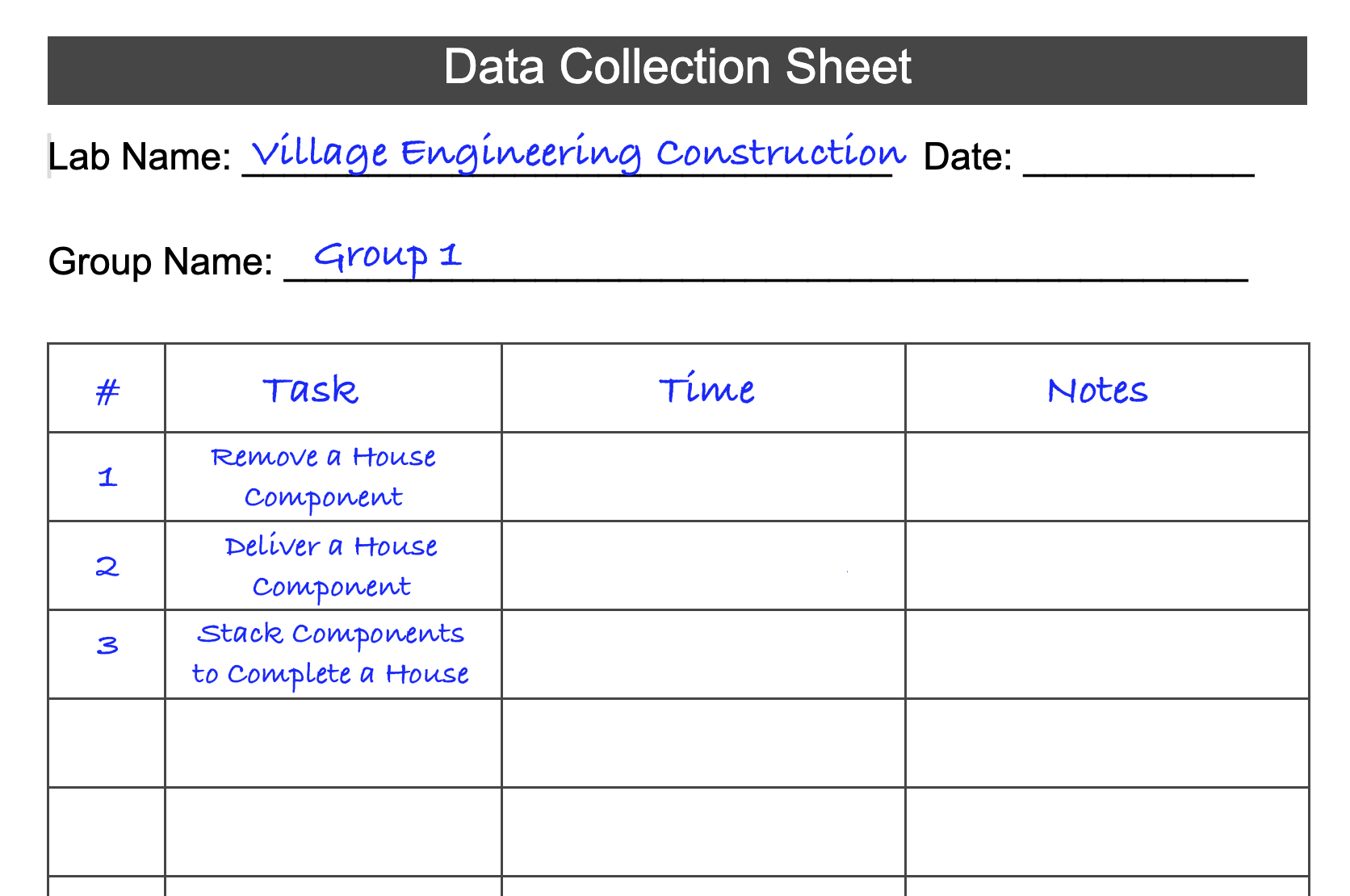
List each task on the Data Collection Sheet. -
Then, practice your strategy with the Hero Robot on the Field. Place the robot on the green starting Tile, and drive the Hero Robot to complete the tasks listed on your sheet in order. Note the time each one was completed. Use the example image below for reference on how to use the Data Collection Sheet.
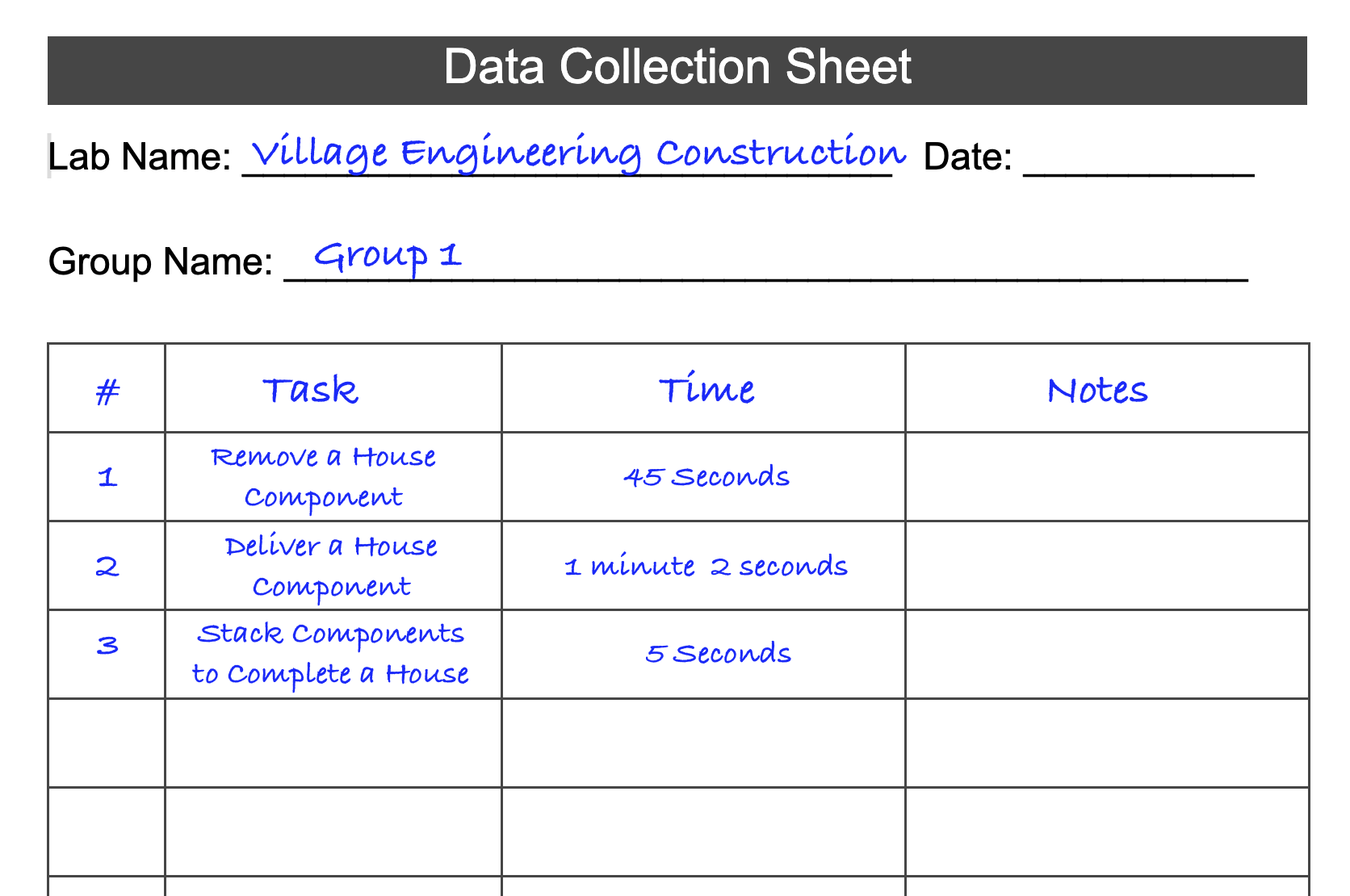
Add the time it takes to complete each task. -
After completing the practice run, reflect on what worked well and what did not. Note things you may want to change as you iterate on your strategy. Use the example image below for reference on how to use the Data Collection Sheet to collect reflection notes.
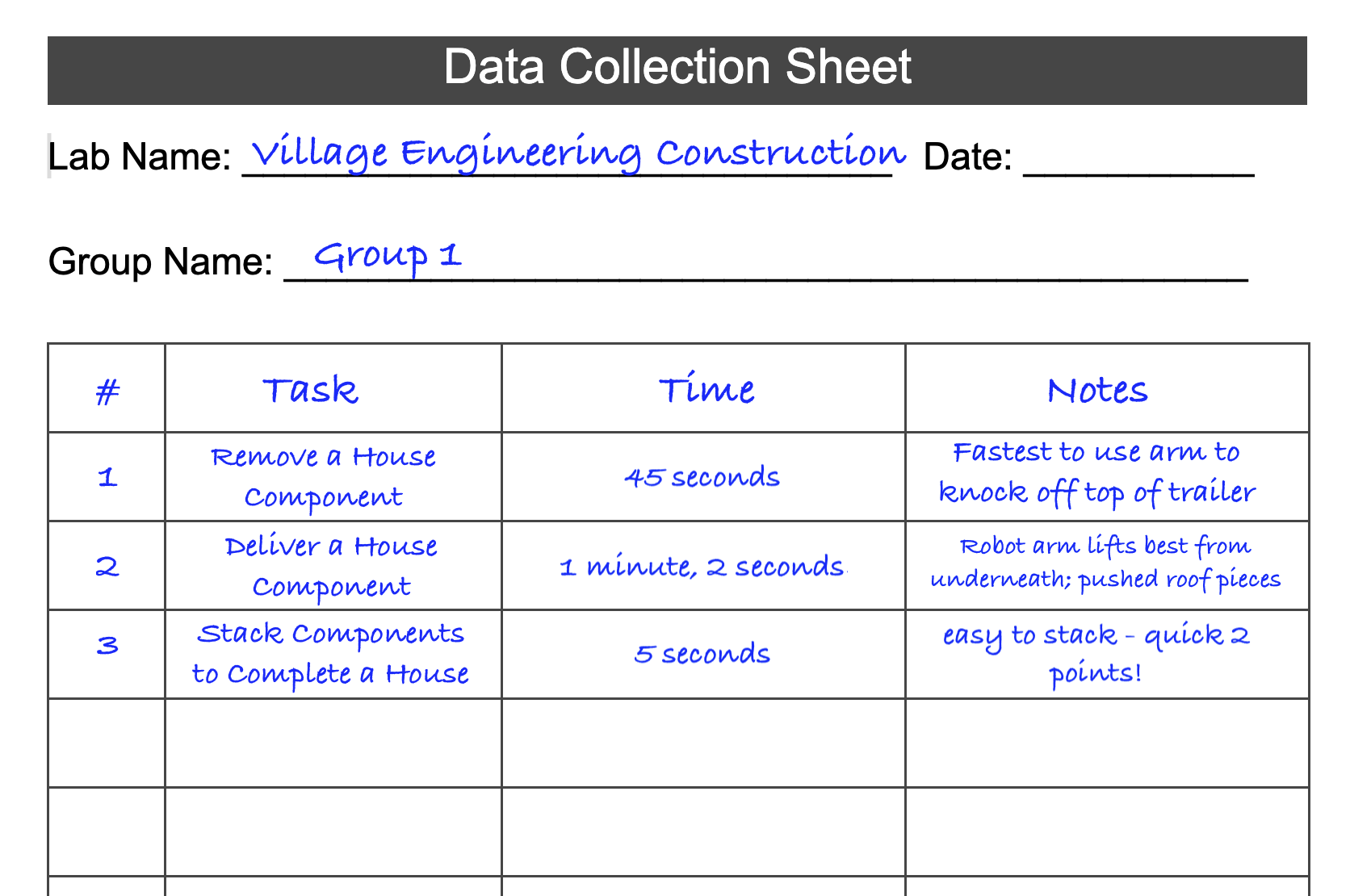
Add notes about each task. - Then, decide what you want to add or change about your strategy, and write it on the lines to prepare to practice again. Add the task order to the top of the sheet to reflect your strategy iteration. Use the example image below for a reference on how to iterate on your strategy using the Data Collection Sheet.
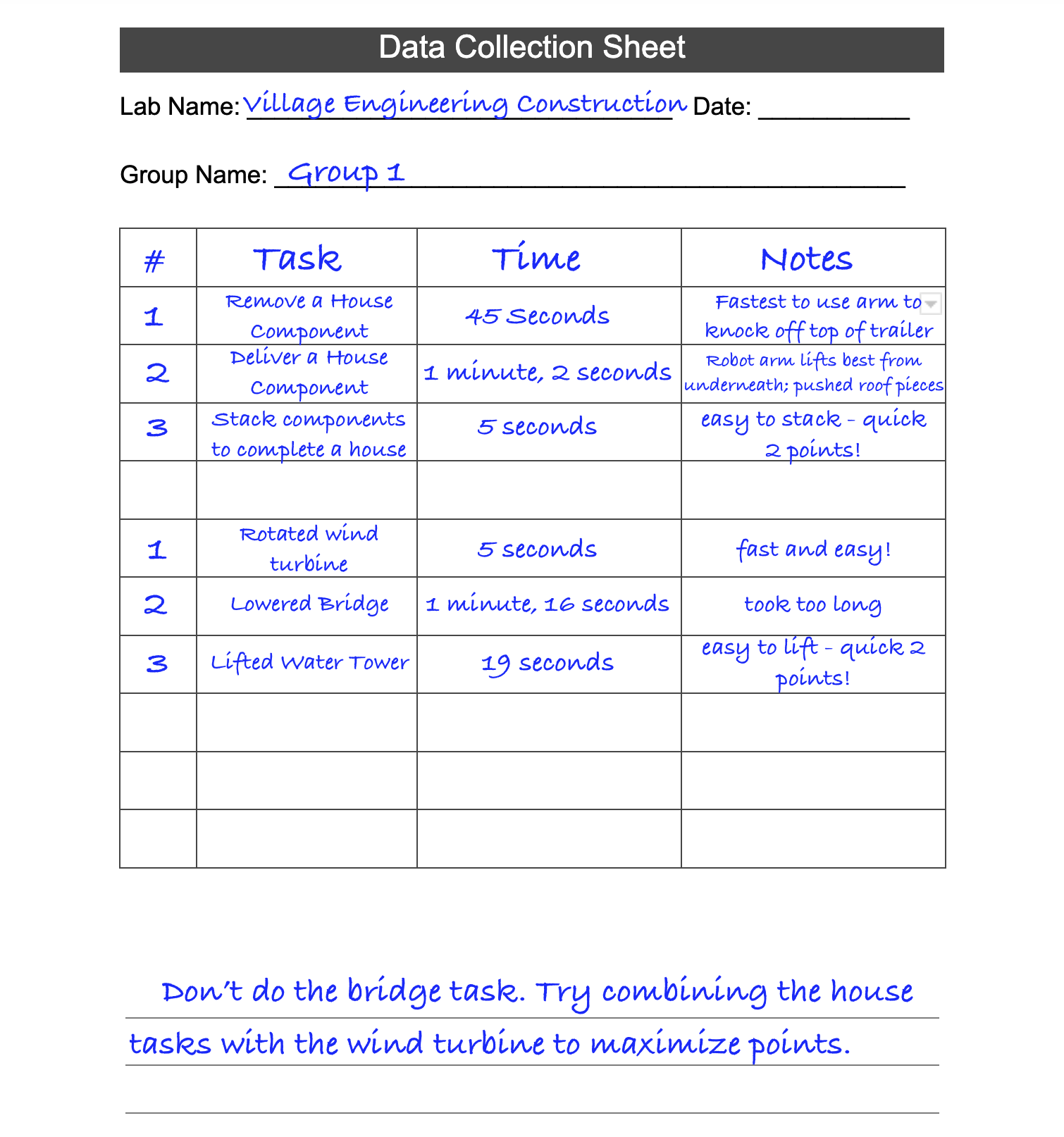
Add strategy iteration and set up for next practice.
- Model how to reset the Field for the next practice. All game elements should be returned to their starting locations, as shown in the Field Setup image below.
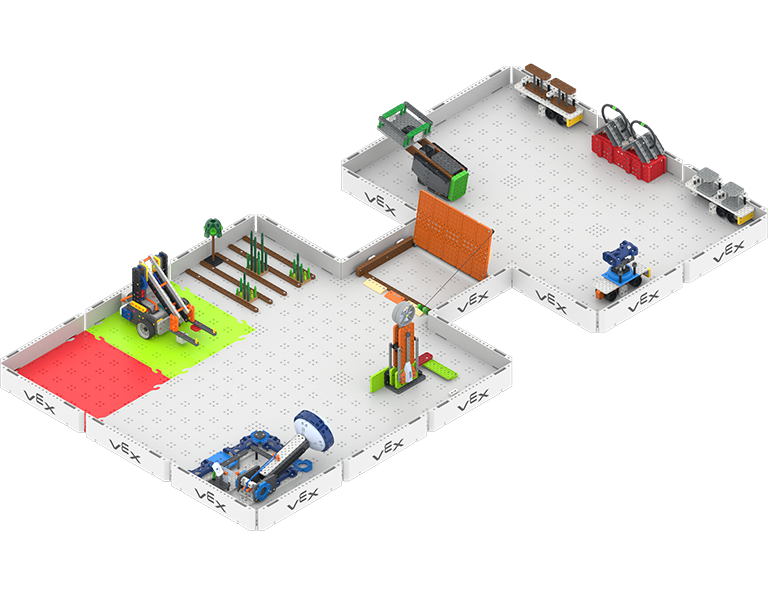
Field setup - If needed, model for students how to launch VEXcode GO, connect their Brain to their device, and open and set up the Drive tab, by following these steps:
- Select the Drive tab in VEXcode GO.

Select the Drive tab - Note: When you first connect your robot to your device, the Gyro built into the Brain may calibrate, causing the robot to move on its own for a moment. This is an expected behavior; do not touch the robot while it's calibrating.
- Select the Moto option in Port 2, to control the arm motor on the Hero Robot.
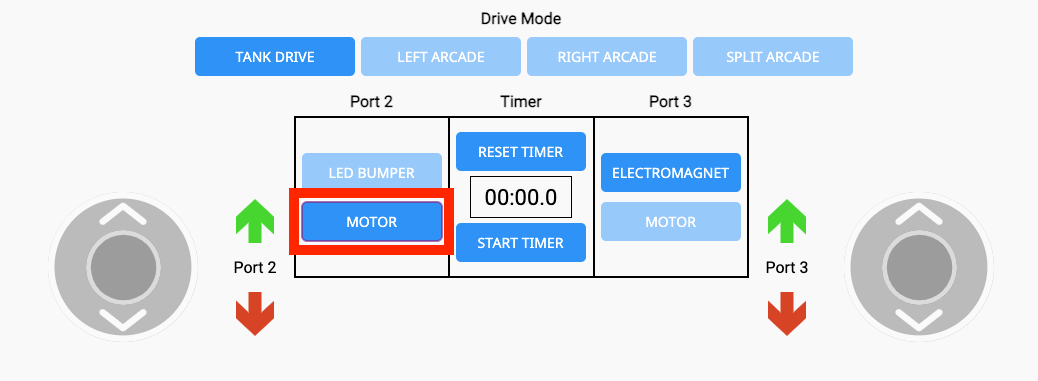
Select the Motor option for Port 2 - Students can change the Drive Mode by selecting the buttons - Tank Drive, Left Arcade, Right Arcade, or Split Arcade. View the video clip below to see the movement of the joysticks as each Drive Mode is selected.
Video file- For reference, the Drive Modes correspond the following controls:
- Tank Drive: Each joystick controls a different motor.
- Left Arcade: One joystick that controls both motors. The joystick is on the left-hand side of the screen.
- Right Arcade: One joystick that controls both motors. The joystick is on the right-hand side of the screen.
- Split Arcade: Two joysticks. One controls left and right movements and the other controls forward and reverse movements.
Students can raise and lower the arm motor using the green and red arrows around Port 2.
- Note: The arrows correspond to the direction the motor is spinning, not necessarily the up and down movements of the arm itself.
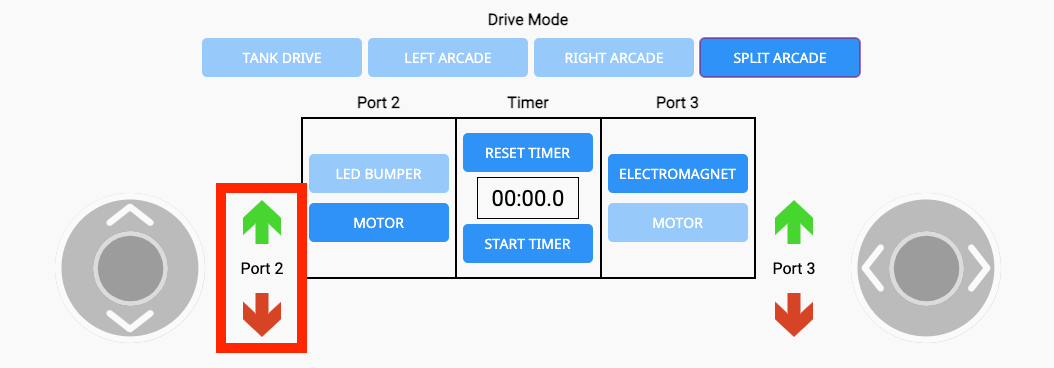
Port 2 Motor controls - Model how to use the engineering design process to develop a strategy:
- FacilitateFacilitate collaboration and communication between team members as they are developing and practicing their strategy. As you circulate around the room, ask questions like:
- How are you deciding together on which tasks to try in your strategy?
- What did you learn about your strategy after practicing it? What do you want to keep or change? Why?
- How are you helping each other to practice your strategy effectively?
- Which task is your favorite? Why? How can you use that strength in your strategy?
You may want to have a practice order, so students know when it will be their turn on the Field. You can make a list of team order, assign specific practice times, or have a sign-up sheet that students can put their names on when they are ready to test their strategy. You can offer as much structure to your practice time as you feel your students need.
- You may want to allow extra time for Play Part 1, so that students can engage more deeply with strategy development in preparation for the competition. The more rounds of practice they have, the better prepared for competition they will be.
- You can use this top down image of the Village Engineering Construction Competition Field for students to be able to plan their robot's path away from the game Field itself.
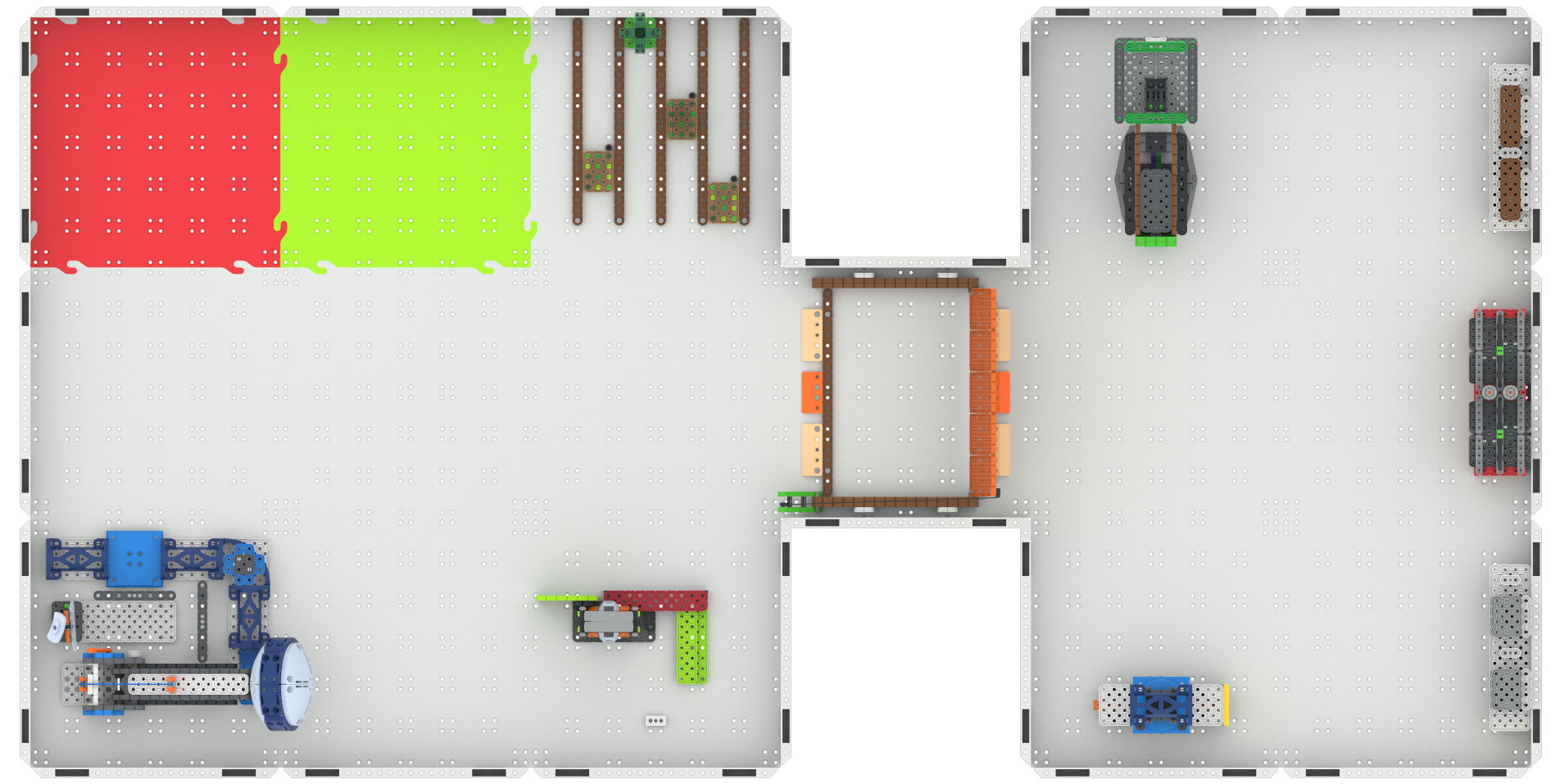
Plan a path for your robot. Facilitate design iterations that can support strategy development. Students may want to make a change to their robot in order to help them better accomplish their strategy. You can use the Engineering Design Process Organizer (Google Doc/.docx/.pdf) to help students document the problem they are trying to solve, their design idea, and how successfully it accomplished their goal.
- To help students stay focused and organized, you may want to have them check in with you to share their design ideas before they begin building. This way, you can help them evaluate the feasibility of the iteration in the time and constraints of your setting. Ask questions like:
- Which task will this design help you to do better? How will your design solve the problem?
- How much time do you think this will take you to build? Can you build it in the time we have in class?
- How will you test your iteration to know if it is successful? What will you look for in your next practice drive to know if it is working?
- How will this design affect your ability to do other tasks in your strategy?
- You can offer constraints like the number of pieces, or the area of the robot that they can adapt, to help students focus on a small and specific iteration, rather than trying to do something like redesign the entire arm.
- RemindRemind students that matches are short in the Village Engineering Construction Competition. They should not practice on the Field for longer than the length of a match, so they can get a feel for what can actually be completed in that time frame. If they cannot accomplish all of the tasks in their strategy in that time frame, it is ok to do less. This is what iterating on your strategy is all about - testing an idea, and learning how to make it better!
Remind students that they should choose small things to change about their strategy between each iteration. Trying to change many things at once may make it unclear what is working well, and what is not. Being systematic about it, and documenting data about their practice driving can help them to make good data based decisions in practice and for the competition.
Remind students that it is ok to have different strategy ideas, however, they need to be able to respectfully listen, communicate, and be open to compromise so they can work as a team. The whole team should be able to explain the strategy, and how it developed when they reach the competition. They are working together, and will compete as one team.
- AskAsk students if they have ever had to develop a strategy for something outside of school, like a sports team or a family game night. How is this experience similar or different? What can they use about what they've learned through the Village Engineering Construction Competition to help them be a better teammate or strategist?
Mid-Play Break & Group Discussion
As soon as every group developed, tested, and iterated on a strategy, come together for a brief conversation.
Now that students have iterated on a strategy with their teams, take a moment to reflect on this process together.
- How did your team work together to develop a strategy? How did you take turns so that everyone's ideas were heard?
- What is one thing that you learned in practice that helped you develop your strategy?
- Did your team compromise on a strategy? What compromise did you make? How did it work?
- What was one challenge about developing a strategy that your team faced? How did you solve the problem?
Part 2 - Step by Step
- InstructInstruct students that they are now going to participate in the Village Engineering Construction Competition! The goal of the competition is to score as many points as you can in a two minute match by completing any of the tasks on the Field!
Note: You can adjust the timing of the matches to best meet your students needs. Longer match times allow students to try to accomplish more tasks and score more points, whereas shorter matches can encourage students to complete fewer tasks and focus more on efficiency and precision.
Use the Village Engineering Construction Activity (Google Doc/.docx/.pdf) as a guide for students as they engage in the competition.
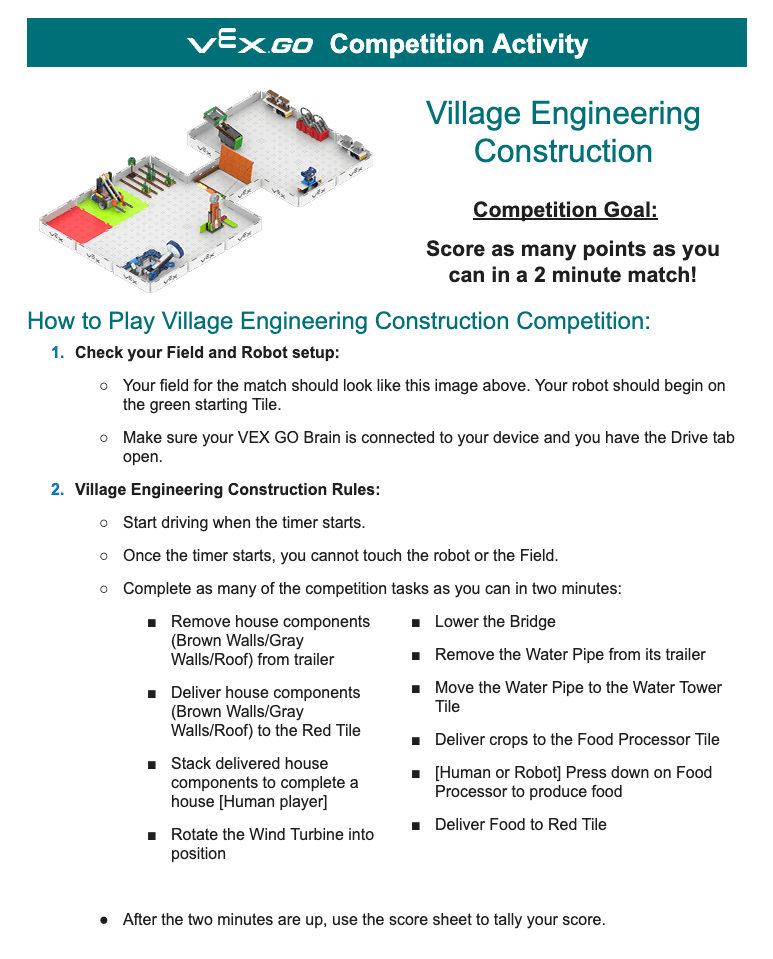
Village Engineering Construction Competition Activity - ModelModel for students how they will participate in the competition matches, and how the competition will run in the classroom.
To learn more about organizing a VEX GO Classroom Competition, see this article.
-
Model how to set up the Hero Robot on the green starting Tile on the Field to begin the match.
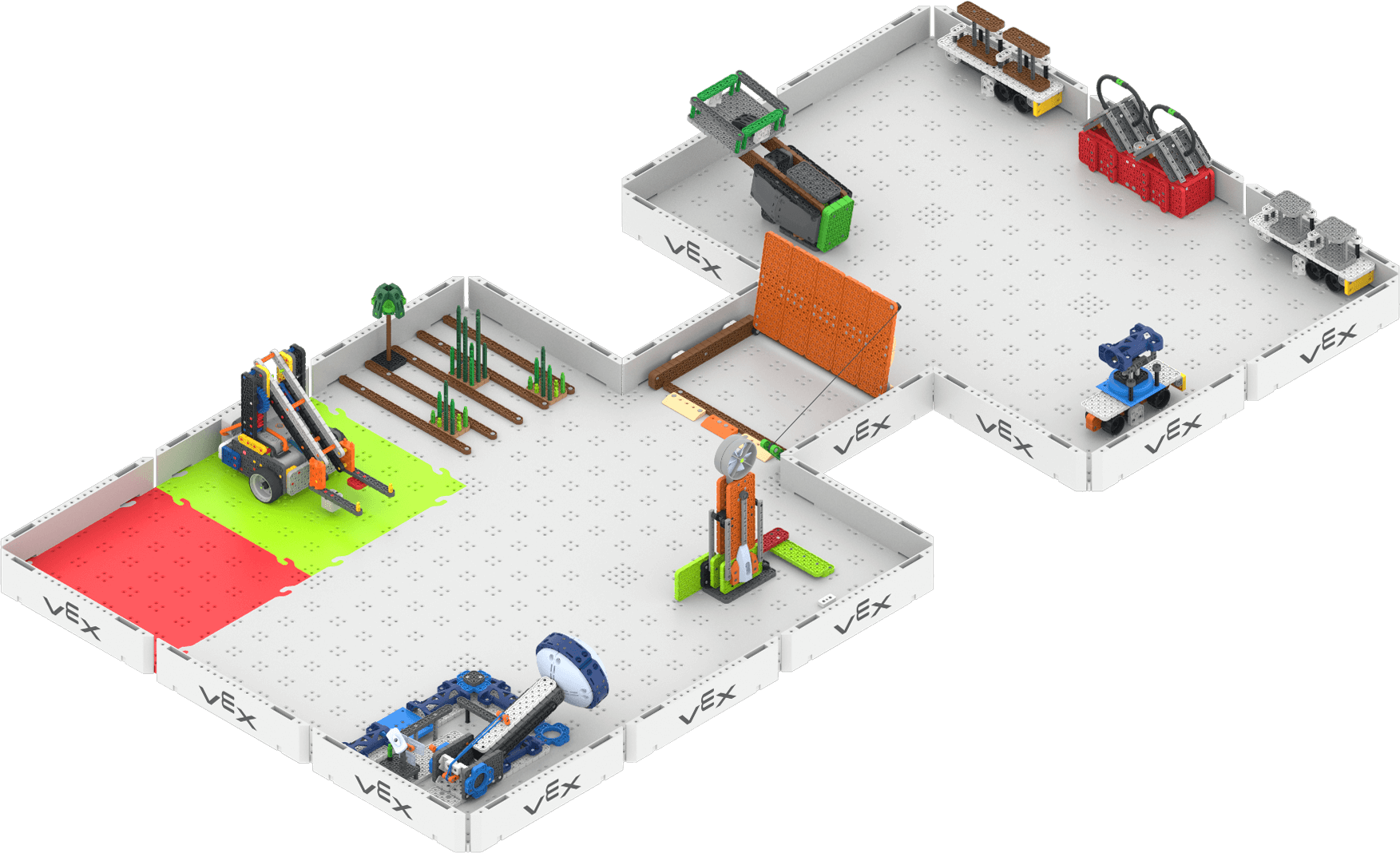
- Share with students the match order and expectations, so that they know what they should be doing during the competition before and after their turn to drive.
- You can use this Match Order template to show teams the order in which they will be competing. You can also use this sheet as a way to keep track of the score after each match. Try to have enough matches so that each student gets a chance to drive the robot at least once.
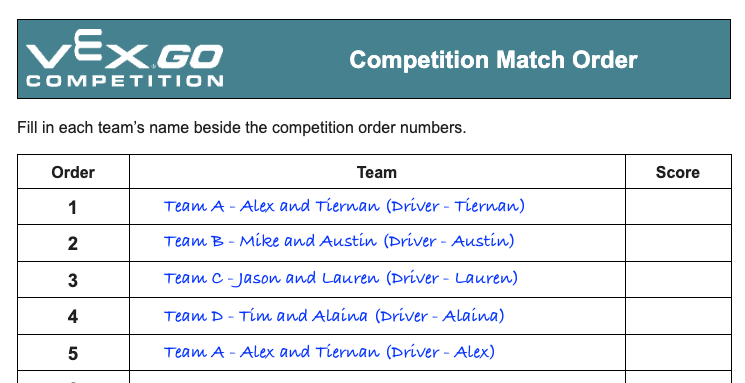
Example of Competition Match order - Demonstrate for students how you will operate the timer, and what to look and listen for to know when to start and stop driving their robots on the Field.
- Show students where they can be seated during the competition matches. If you have practice areas or other spaces students can be in during the competition, show them these areas as well, and explain how they are to be used.
- Review expectations for how to be a respectful participant in the competition. Encourage students to cheer for one another, and to be excited about the competition – this is meant to be a fun classroom experience! Be sure that students are showing good sportsmanship before, during, and after each matches.
- You can use the Village Engineering Construction Competition Activity Scoring Sheet (Google Doc/.docx/.pdf) to help students calculate scores at the end of each match. You can print or project the Village Engineering Construction score sheet for each match, so that students can tally their own scores to add to the Leaderboard. Use the example image of a completed scoring sheet below as a reference.
-
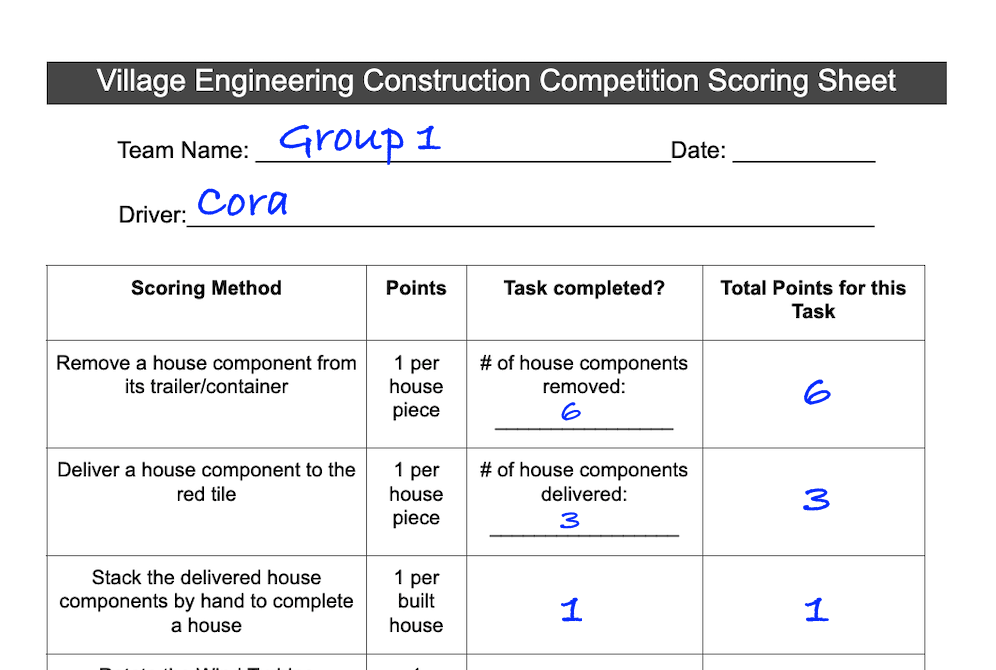
Village Construction Competition Score Sheet
- If you are using a VEX GO Leaderboard, show students how the scores will be entered and displayed on the Leaderboard.
- Model how to reset the Field for the next match. All game elements should be returned to their initial locations and places, as shown in the image above.
-
- FacilitateFacilitate the classroom competition matches, and engage students in conversations about their driving and collaboration between matches. Use discussion prompts like:
- Before the start of a match:
- Which team member will be driving? Can you explain your strategy, or what you are going to try to do, in this match?
- What is one strategy iteration that you think will make you more successful? Why?
- Did your strategy change the order of tasks mixed up from the original lab orders? Why? Or why not?
- What is your team's favorite part of your strategy? Why?
- During a match:
- Watch which tasks the team chose to do. What do you notice?
- Watch how the robot is moving around the Field. What do you notice?
- Watch how the driver is controlling the arm and movement of the Hero Robot. What do you notice?
- After a match:
- What is something you learned from your driving that you will use in your next match?
- What is something you learned from watching another driver that can help you in your match?
- Before the start of a match:
- RemindRemind students that they are more likely to be successful in the competition if they cooperate and work together with their teammates! Encourage students to enjoy the experience of competing, that is just as valuable a learning experience as the score at the end of the match.
Remind students to always use respectful, kind language throughout the competition. It is great to be excited, but we still have to demonstrate good sportsmanship!
- AskAsk students about how they will share what they have learned throughout the competition with their friends and family. What parts will they tell them about? How can they show their learning and excitement to those who are not in the class?